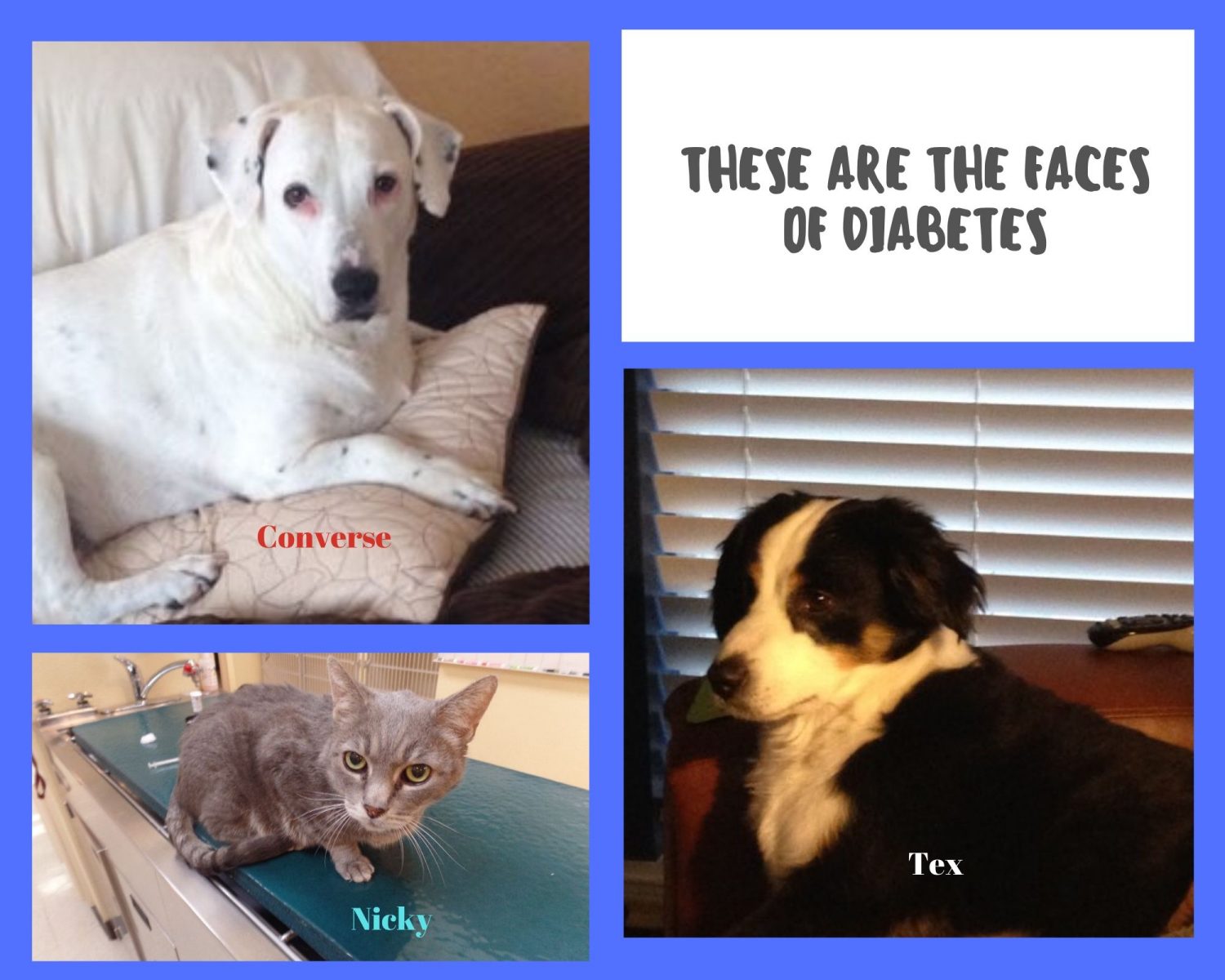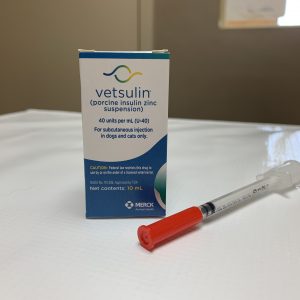November is Pet Diabetes Awareness Month
While there are some obvious similarities in human diabetes and diabetes in our pets, we tend to approach treatment a little differently in  pets. Let’s review and see how much you know about diabetes in pets!
pets. Let’s review and see how much you know about diabetes in pets!
WHAT IS DIABETES?
Diabetes Mellitus occurs when your pet’s body produces too little insulin, stops making insulin completely or has an abnormal response to insulin. Pets and humans alike need insulin so that our bodies can convert glucose into energy to use as fuel.
If we don’t have enough insulin and we cannot convert glucose in our bodies, glucose then builds up and we become “HYPER”glycemic. This means we have too much glucose or our glucose is too high. Hypoglycemia is the exact opposite. You may also know this as low blood sugar. More information regarding diabetes mellitus in pets can be found at veterinary partner.
HOW CAN YOU PREVENT DIABETES IN YOUR PET?
Diabetes affects some breeds specifically due to genetics. Overall a healthy diet plus maintaining a healthy weight along with exercise goes a long way to staving off the dreaded disease. Some medications used long term can lead to diabetes so it is important not to share medications between pets without the advice of your veterinarian. See your veterinarian regularly and monitor your pet’s health. We can diagnose diabetes early by performing routine lab work and checking glucose levels routinely.
HOW DO YOU KNOW IF YOUR PET HAS DIABETES?
Pet owners often notice behavioral changes at home that lead to veterinary visits that result in a diabetes diagnosis. These
changes include drinking more than normal, urinating more than normal and often times eating more than normal. In spite of eating more than normal, they still may be losing weight. Your pet may also experience some muscle weakness, lethargy and dull coat or unkempt hair.
Owners most commonly bring their pets into the veterinary hospital when they notice increased thirst and increased urination. Often perfectly house trained dogs are having accidents in the house. For cats, owners notice large amounts of urine in the litter box or the cat is urinating outside the litter box.
HOW IS DIABETES DIAGNOSED?
So now you suspect your pet may have diabetes, what is next? We diagnose diabetes by measuring the glucose in your pet’s blood and urine. Your veterinarian will also check your pet’s liver enzymes and look at your pet’s electrolytes. The earlier diabetes can be initially diagnosed the better. Earlier diagnosis means earlier treatment and getting your pet’s blood sugar under control means a better chance in him living a longer, healthier life. We provide both in house and send out diagnostics to get answers for your pet health questions.
Up until now, species has not played a part in determining how we identify or diagnose diabetes. Now we are going to get into treatment and here is where things start to differ between pets and humans and also dogs and cats.
TREATMENT
Treatment comprises a big area when it comes to pets and diabetes. For both dogs and cats the beginning is the most difficult and expensive time of treatment. When we first diagnose diabetes a pet’s blood sugar is usually high and the pet is feeling pretty crummy. Our first goal is  to find out how their blood work looks and how their body is handling the excess amounts of glucose in their system. How are their organs holding up? Once the doctor has these answers he or she will make a plan to start your pet on insulin and often a special diet. Insulin is started at a very conservative dose and gradually increased over time, under the recommendation of your veterinarian.
to find out how their blood work looks and how their body is handling the excess amounts of glucose in their system. How are their organs holding up? Once the doctor has these answers he or she will make a plan to start your pet on insulin and often a special diet. Insulin is started at a very conservative dose and gradually increased over time, under the recommendation of your veterinarian.
After starting insulin, your pet should receive a glucose curve every 2 weeks until glucose regulation is achieved. Adjustments in insulin dosing depend on the results of the curve. To do a blood glucose curve we collect and test a blood sample every 2 hours for at least 5 samples. A glucose curve tells us how long an insulin dose is effective.
This is where things get really different between the diabetic dog and the diabetic cat. Dogs and cats may take different types of insulin. Their dietary needs are different and their treatment and progress monitoring differ as well.
FELINE DIABETES
Let us start with cats. When cats get diabetes they don’t always have it for life. They can actually go into a kind of remission with diabetes and revert back to a more normal blood sugar. This makes them a little trickier to manage at times.
If there has not been too much permanent damage to the pancreas and the blood sugar can be regulated quickly the cat can become normal or non-diabetic. This needs to be done with a combination of insulin and proper diet so that obese cats can achieve regulation of their blood sugar by losing weight slowly.
The best diet to achieve this with is a low carbohydrate/high protein diet. Canned cat food is a lower carbohydrate choice than dry food. The most important thing is to consult your veterinarian when considering what diet to feed to your diabetic cat. Diabetic cats need a few specific nutrients in particular so a diabetic specific food works best.
Unfortunately, while cats are more like a type II human diabetic, dogs are more like a type I. Dogs are completely insulin dependent. So we must treat your dog’s diabetes with insulin, diet and exercise as well.
CANINE DIABETES
Dogs can generally be regulated on what they are eating but most of the time your veterinarian will opt to have you feed a prescription diet especially for diabetes. Most of these diets contain high levels of fiber. This is preferred because of these diets slow absorption of sugars which helps maintain a more regulated blood sugar level throughout the day. Fiber also helps by making the body’s tissues more sensitive to insulin, which helps with regulation. Your veterinarian can instruct you on how to specifically feed and give insulin to your dog.
Once diagnosed we set up a plan for your dog that includes diet, insulin, and what you can expect for future testing. In the beginning expect a glucose curve every 2 weeks until your pet’s glucose regulation is achieved. It may take 3 to 5 curves before this happens. You will also need to prepare for the changes to your dog’s eyesight that will happen. Diabetes causes cataracts in dogs. You can seek treatment for the cataracts from a veterinary ophthalmologist. We recommend that if you want to preserve your dog’s sight seek treatment as early as possible.
LIVING WITH DIABETES
Diabetes can be expensive at first and it can alter your schedule but it is definitely something that you can adjust to. Caring for a diabetic pet may sound complicated. The reality is that it is overwhelming in the beginning. As time goes by it gets easier until it is second nature. We do our best at Hill Country Animal Hospital to make it as easy as possible for you to care for your pet. We are here to help. You can have a diabetic pet and still have a life. And your pet can have a quality life for years to come!
